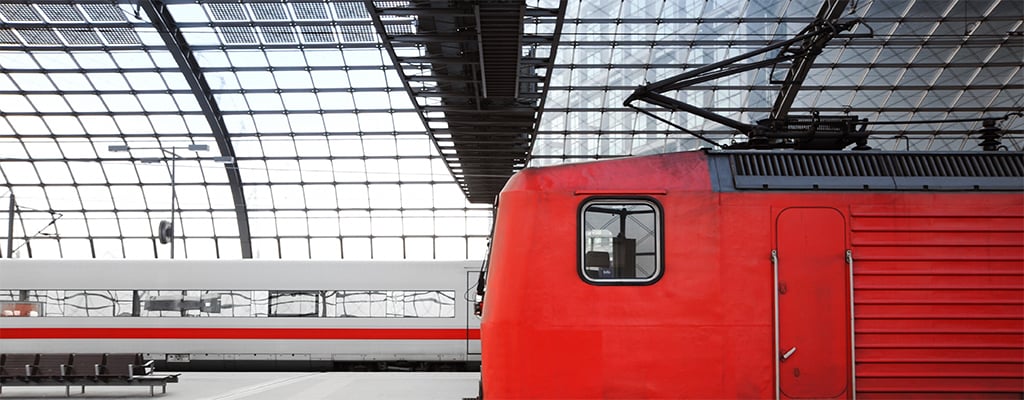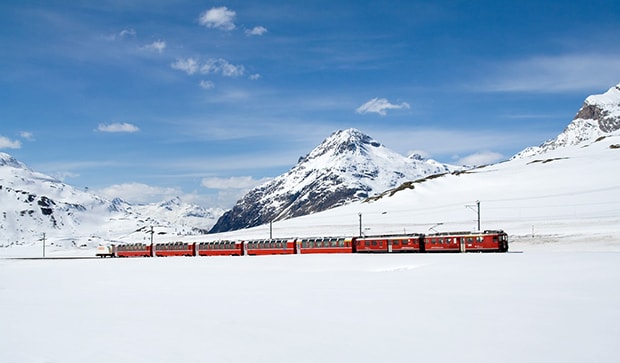
Trend Insight
Reliability under Harsh Conditions
Train roofline systems must reliably transmit the high-voltage power needed to ensure trains can safely travel at high speeds. By: Elizabeth Da Silva Domingues, Ph.D., Engineer Manager, High-Voltage Rail
Train roofline systems must perform under a wide range of harsh conditions. Particularly vulnerable to damage from these conditions are the system’s critical components: switchgear, insulators, intercar cables, surge arrestors, bushings, and downleads. Since these are positioned on – and connected to a transformer through – the roof, these components must both withstand harsh conditions and reliably transmit power at 25 kV (or 15 kV), all while ensuring that passengers are safe and operations are not interrupted. By understanding the risks of not properly protecting roofline systems, and identifying the options for optimizing the performance and design of these systems, train manufacturers can increase the life cycle of their trains and avoid unnecessary interruptions to service.
Harsh Conditions
Train roofline systems must have the capacity to operate under any condition:
- Mechanical shock and vibration
- Humidity, pollution, airborne salt, fast air flows
- High altitudes and sudden temperature changes
- High levels of electrical stresses – electric field concentration, switching transients, harmonics, and lightning overvoltages
Atmospheric Conditions
When a roofline system does fail, the cause is often flashover (electric arcs). This can occur in two ways. When the electric field at three points (metal, solid insulation, air) becomes stronger than the capacity of the external insulation to withstand the stress (breaking the clearance distances). Or when the surface of the insulation becomes conductive (breaking the creepage distance). In both cases, air carries the power in an electric arc. The result is a short circuit, from the live components to either the grounding points or the body of the train. The leads to immediate power loss. The likelihood of flashover increases when one of two environmental conditions occurs: When an electric field is concentrated, or when the external insulation’s dielectric strength is weakened. The former happens when the roofline-system components are poorly designed or inappropriately protected; the latter results from the combined impact of several factors, such as pressure or humidity/pollution.
By using quality insulating materials, and installing these correctly, train manufacturers can avoid roofline system failures.
The rapid worldwide growth of electrified rail (i.e., high speed) systems has increased the complexity of protecting roofline components. For example, lines that extend across different climates, such as one being built to traverse Europe, Asia, and the Middle East, must withstand significant atmospheric shifts: extreme temperatures, high humidity, high altitudes, high levels of pollution, or any combination of these factors. When insulators or terminations surfaces are simultaneously exposed to humidity and pollutants, the combination can cause leakage currents, which increases the probability of flashovers, This combination also makes the high-voltage systems more vulnerable to internal puncture. When in a high altitude with low air pressure, the system is exposed to gaps between air molecules. As a result, electrons have can generate more kinetic energy. As Paschen's law states, this reduces the voltage at which flashover will occur, over a specific gap, leaving the roofline system more vulnerable to failure.

Mechanical Considerations
The challenge of protecting roofline systems is complicate by a large number of variables. Since every railway line is unique and a “one-size-fits-all” approach is neither possible nor economical, train manufacturers must instead establish a reliable power system that recognizes each line's operating environment. This has a direct effect on the performance of components across the life cycle.In one case, high air flows force could flex and bend insulating bushings out of shape, subsequently impacting the performance. In another case, relative movements of cars, which causes mechanical flexing in three axes, could affect the performance of high-voltage jumper cables which carry electrical power across the gap between train cars. Ignored, this shock and vibration can disrupt the power transmission. These cyclic mechanical loads inevitably lead to wear – both on the cable and to the equipment that the cable is connected to, such as insulator brackets or high voltage cable terminations. This in turn affects the system's capacity to reliably and effectively transmit current and provide high-voltage withstand. To avoid this, it is crucial to consider the connectivity that occurs throughout the entire system's individual electrical and mechanical components.
Quality Materials Matter
The quality of the materials used in a roofline system can have a major impact on performance in harsh conditions. Some connectors – such as nuts, bolts, brackets, and braided connectors – are often specified for the lowest price. It is important to remember that the materials used for these lower-cost connectors are vulnerable to corrosion – and this corrosion can quickly spread across insulator surfaces, resulting in damage to high-value copper connectors. Once affected, the entire system's electrical and mechanical performance is compromised and weakened. One example of this mistake is using a low-grade nut on a copper conductor, without inserting a proper component to separate the two. This type of mistake unnecessarily damages the connection. By using quality insulating materials, and installing these correctly, train manufacturers can avoid roofline system failures. These include weak performance, and premature degradations resulting from using materials not developed for high-voltage use under extreme conditions.
Minimizing Risk
Train manufacturers face a crucial challenge. They are expected to offer comfortable spaces for passengers, run efficiently while consuming less power and operating at faster speeds, and perform reliably anywhere anytime. To optimize the performance of the roofline system, train manufacturers can implement one of these approaches for minimizing the risk of service interruptions.
1
Finite Element Analysis
This technique helps train manufacturers anticipate the electrical and mechanical stresses that components will experience over the course of the system’s life cycle. As a result, they can identify and reinforce the weak points in the system.
2
Single Subsystem Procurement
This enables train manufacturers to outsource risk – and benefit from the knowledge of involving specialists in high-voltage systems. Often, train manufacturers keep their costs down by sourcing minor components from a range of third-party suppliers, and then combining these in-house. This practice overlooks the fact that simple components are as important as major components. For example, if the simple connectors and structures are not specified as engineering components, the entire high voltage system will be vulnerable to failure. Using a single supplier for all components can lead to a system designed thoughtfully throughout, to operate as a single system and to accommodate the unique operating conditions of a particular railway line. Although many train manufacturers have the expertise to design their own systems, working with specialist suppliers helps ensure that specifications for lower-value roofline components – such as copper braids or bars, fasteners (nuts, bolts and washers) – are accurate.
3
Weakening Electric Fields
There are three ways to reduce the strength of electric fields, through good design. The first is to increase distances (which does not necessarily mean height increases) between live components and the train structure, called clearance and creepage distance. This must follow all technical aspects properly and effectively. The second involves using components that are rounded and smooth in shape – because a pointed surface concentrates charged particles, increasing electric field strength. The third is to allow for fast run-off of rainwater in storm conditions, as electrical withstand can be severely compromised by water flow (shortening clearance distances or creepage length).
Summary
When rail operators, train manufacturers, and rail suppliers to work together to protect roofline systems from the environmental conditions of a train's particular route, they are ensuring that the trains will operate as expected under any conditions – and that the people who rely on its operation will get the service they expect without delays and interruptions.


